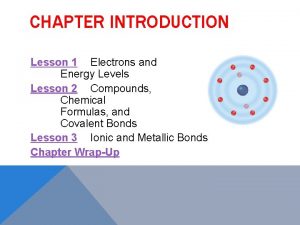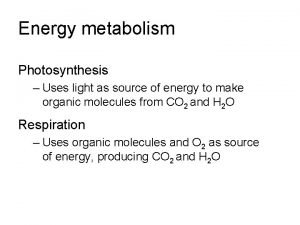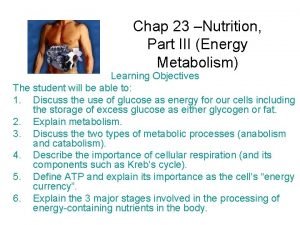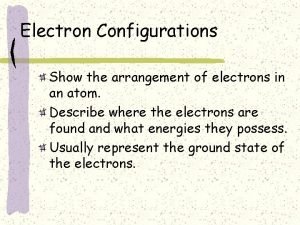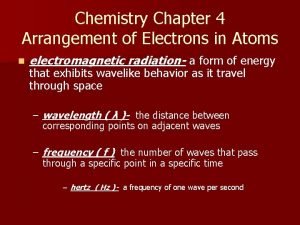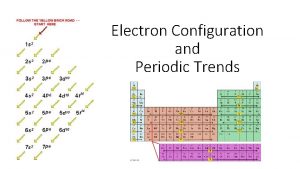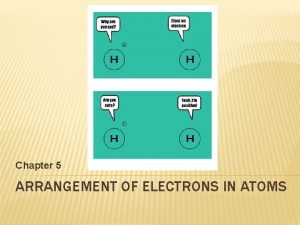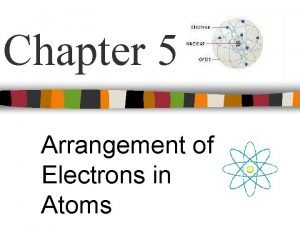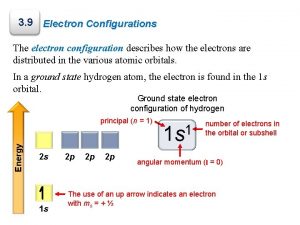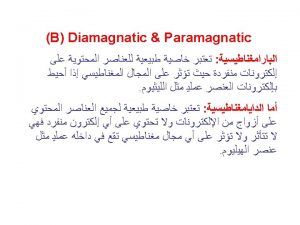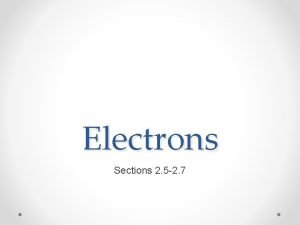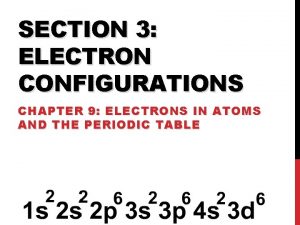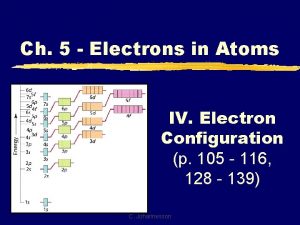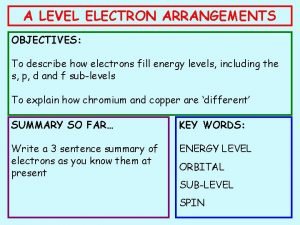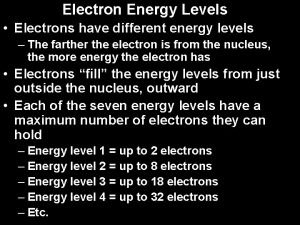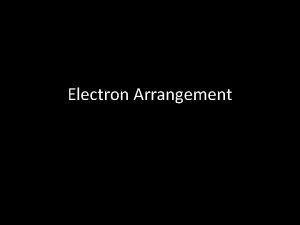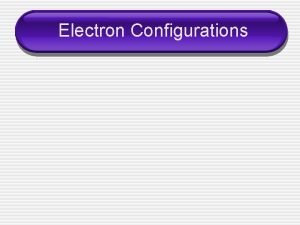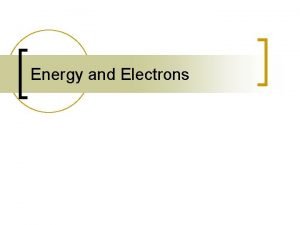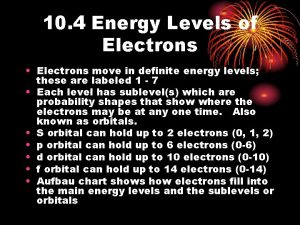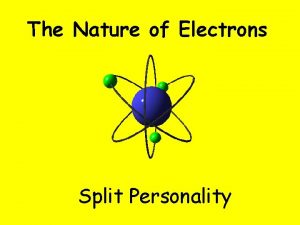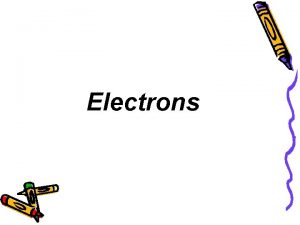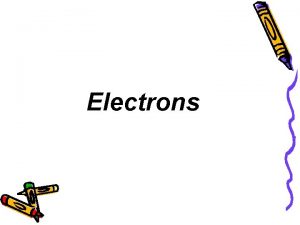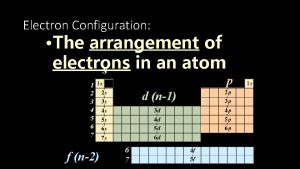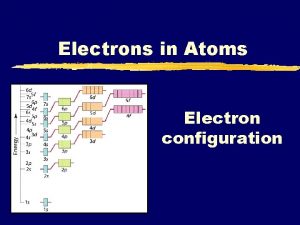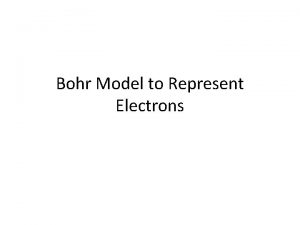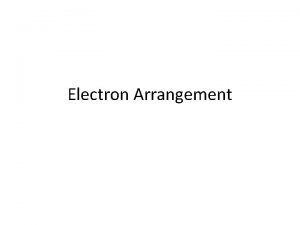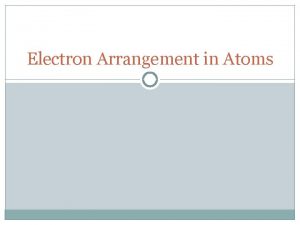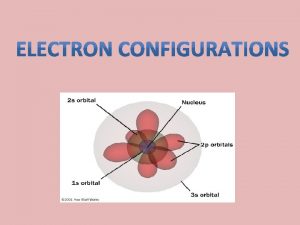Electron Arrangement Energy Levels Electrons that are closer






























- Slides: 30

Electron Arrangement

Energy Levels Electrons that are closer to nucleus have lower energy Further away = Higher energy So the further away from the nucleus an electron is, the more energy it has The electron cloud is organized into shells. Each shell has a max.

# of Electrons in Each Energy Level 1 st Level = 2 electrons 2 nd = 8 e 3 rd = 18 e 4 th = 32 e- Electrons must occupy the lowest energy level or orbital first

Bohr Diagrams show each of the energy levels of the atom Show every electron that the atom has orbiting around it. These electrons are organized into the different shells or orbital levels 1 st level - 2 electrons 2 nd level - 8 electrons 3 rd level - 18 electrons Examples:

Bohr Diagrams: You Try Draw me the Bohr Diagram of each of the following: H B F Si


Valence Electrons in outermost shell = valenceelectrons Determine the properties of the element Will it bond with other elements? Which ones? Valence electrons tell us the answers.

Each column (except for the transition metals) has a set number of valence electrons

YOU-TRY! Use the group number above the column to determine the number of valence electrons. Ø 1 valence Sodium – (Na) electrons Boron – (B) Ø 3 valence Chlorine – (Cl) electrons Neon – (Ne) Ø 7 valence electrons Ø 8 valence

Lewis Dot Diagrams Uses the symbol of the element and dots to represent VALENCE electrons

Lewis Dot: How To… Write the symbol of the element Figure out how many valence electrons it has Each side of the symbol can only hold 2 electrons 1 dot = 1 electron Each side must get one electron before any side can get 2 Max Number = 8 dots for 8 electrons (You can’t have more than 8 electrons on the outside row)

Electron Arrangement Electron Configuration and Orbital Diagram

Remember… Electrons must occupy the lowest energy level or orbital first 1 st Level = 2 electrons 2 nd = 8 e 3 rd = 18 e 4 th = 32 e-

But what is an orbital? Suppose you had a single hydrogen atom You plot where the electron is at any given time 2 seconds later, you again plot where the electron is You never know the path that the electron took to get from A to B You continue doing this every 2 seconds for an hour If after that hour, you graphed each of these plotted points, you would have a picture that looks like the one above.

But what is an orbital? The same basic idea occurs for the second orbital (or ring of electrons) that will form around the nucleus. Notice the gap between the two orbitals An Orbital is the general region where an electron is very likely to be found. Electrons DO NOT orbit An orbit is a predictable elliptical

Electron Configuration The purpose of the Electron Configuration is to identify basically where each of the electrons are located around an atom Each energy level (2, 8, 18, 32) contains the different sub-orbitals There are 4 types of sub-orbitals S, P, D, F S (holds 2 e-) D (holds 10 e-) P (holds 6 e-) F (holds 14 e-)

Electron Energy Levels Each type of suborbital has a different shape and gets slightly more complicated The reason for these shapes is to get as many electrons as possible, as close to the nucleus as possible, while keeping the electrons separated from each other

Electron Configuration So the purpose is to tell me how many electrons are in each orbital

Electron Configuration So the purpose is to tell me how many electrons are in each orbital So for instance: H = 1 s 1 He = 1 s 2 Li = 1 s 2 2 s 1 (has 1 electron in the 1 s orbital) (has 2 electrons in the 1 s orbital and 1 electron in the 2 s orbital) B = 1 s 2 2 p 1 All the way up to: Ar = 1 s 2 2 p 6 3 s 2 3 p 6

Orbitals and the Periodic Table This is the part you have to know!!

Electron Energy Levels The first Trick…. The periodic table itself…. This shows the ENERGY LEVEL and TYPE OF ORBITAL

Electron Energy Levels This shows the ENERGY LEVEL and TYPE OF ORBITAL AND the NUMBER OF ELECTRONS in that type of orbital at that energy level

Electron Energy Levels Or a second trick that you will learn in chemistry…

Electron Energy Levels Or a third Trick…. The energy level table (PS: This is given to you on your test)

Electron Energy Levels h

Electron Energy Levels Try out a few: Be =1 s 2 2 s 2 O = 1 s 2 2 p 4 P = 1 s 2 2 p 6 3 s 2 3 p 3

Orbital Diagrams / Electron Spin Remember electrons have a negative charge And you recall that Like Objects Repel Meaning that two electrons want to avoid each other as much as possible. So how do they do that? They can do that because electrons spin And two electrons within the same orbital will spin in opposite directions

Orbital Diagrams Basically, for each new orbital (or energy level) you need to fill with arrows that indicate the spin There are two options of arrows: up or down Rules: Each orbital must be filled before you move onto the next orbital Within an orbital, you must fill ALL of the up arrows before you fill the down arrows These diagrams are called Orbital Diagrams

Orbital Diagrams Remember: Each S orbital has only 2 electrons, so it just gets one up arrow and one down arrow. Each P orbital has 6 electrons, so you place the 3 up arrows before you go back and pair any of the up arrows with down arrows. Example: Hydrogen Helium Carbon

Orbital Diagrams: Recap Basically, each orbital gets filled with all of the electrons before you can move up to the next orbital 1 s, then 2 p, then 3 s You must put in all your up arrows for that orbital before you can put in any down arrows If you have any up arrows with no down arrow partner, it is considered an unpaired electron
 Antigentest åre
Antigentest åre Energy levels and orbitals
Energy levels and orbitals Lesson 1 electrons and energy levels
Lesson 1 electrons and energy levels Lesson 1 electrons and energy levels
Lesson 1 electrons and energy levels Energy level periodic table
Energy level periodic table Ch 7 a closer look energy metabolism pathways
Ch 7 a closer look energy metabolism pathways Chapter 7 a closer look energy metabolism pathways
Chapter 7 a closer look energy metabolism pathways Phân độ lown ngoại tâm thu
Phân độ lown ngoại tâm thu Block av độ 2
Block av độ 2 Thơ thất ngôn tứ tuyệt đường luật
Thơ thất ngôn tứ tuyệt đường luật Thơ thất ngôn tứ tuyệt đường luật
Thơ thất ngôn tứ tuyệt đường luật Walmart thất bại ở nhật
Walmart thất bại ở nhật Tìm độ lớn thật của tam giác abc
Tìm độ lớn thật của tam giác abc Con hãy đưa tay khi thấy người vấp ngã
Con hãy đưa tay khi thấy người vấp ngã Tôn thất thuyết là ai
Tôn thất thuyết là ai Gây tê cơ vuông thắt lưng
Gây tê cơ vuông thắt lưng Sau thất bại ở hồ điển triệt
Sau thất bại ở hồ điển triệt Electronic configuration is arrangement of electrons in
Electronic configuration is arrangement of electrons in Arrangement of electrons in atoms chapter 4 test
Arrangement of electrons in atoms chapter 4 test Aufbau principle
Aufbau principle Chapter 5 review arrangement of electrons in atoms
Chapter 5 review arrangement of electrons in atoms Chapter 5 arrangement of electrons
Chapter 5 arrangement of electrons Chapter 5 arrangement of electrons
Chapter 5 arrangement of electrons The most stable arrangement of electrons is
The most stable arrangement of electrons is Paramagnetic unpaired electrons
Paramagnetic unpaired electrons Dot symbol
Dot symbol Electrons in atoms section 3 electron configuration
Electrons in atoms section 3 electron configuration Electron configuration for 5 electrons
Electron configuration for 5 electrons Aluminium oxide ionic bonding
Aluminium oxide ionic bonding Tetrachloromethane electron arrangement
Tetrachloromethane electron arrangement Electron level arrangement
Electron level arrangement



